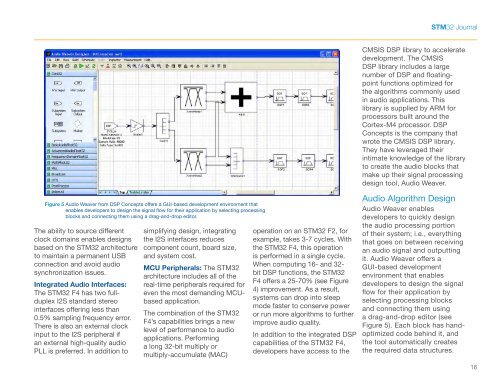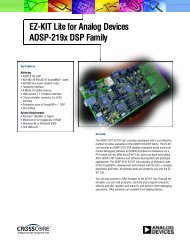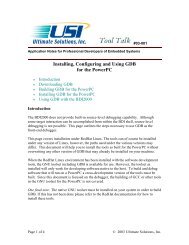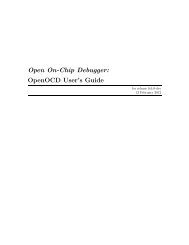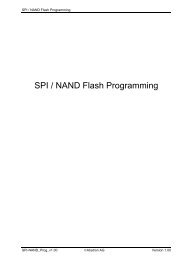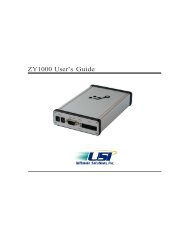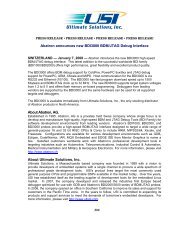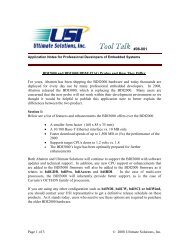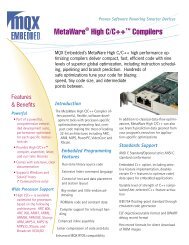STM32 Journal - Digikey
STM32 Journal - Digikey
STM32 Journal - Digikey
You also want an ePaper? Increase the reach of your titles
YUMPU automatically turns print PDFs into web optimized ePapers that Google loves.
<strong>STM32</strong> <strong>Journal</strong><br />
CMSIS DSP library to accelerate<br />
development. The CMSIS<br />
DSP library includes a large<br />
number of DSP and floatingpoint<br />
functions optimized for<br />
the algorithms commonly used<br />
in audio applications. This<br />
library is supplied by ARM for<br />
processors built around the<br />
Cortex-M4 processor. DSP<br />
Concepts is the company that<br />
wrote the CMSIS DSP library.<br />
They have leveraged their<br />
intimate knowledge of the library<br />
to create the audio blocks that<br />
make up their signal processing<br />
design tool, Audio Weaver.<br />
Figure 5 Audio Weaver from DSP Concepts offers a GUI-based development environment that<br />
enables developers to design the signal flow for their application by selecting processing<br />
blocks and connecting them using a drag-and-drop editor.<br />
The ability to source different<br />
clock domains enables designs<br />
based on the <strong>STM32</strong> architecture<br />
to maintain a permanent USB<br />
connection and avoid audio<br />
synchronization issues.<br />
Integrated Audio Interfaces:<br />
The <strong>STM32</strong> F4 has two fullduplex<br />
I2S standard stereo<br />
interfaces offering less than<br />
0.5% sampling frequency error.<br />
There is also an external clock<br />
input to the I2S peripheral if<br />
an external high-quality audio<br />
PLL is preferred. In addition to<br />
simplifying design, integrating<br />
the I2S interfaces reduces<br />
component count, board size,<br />
and system cost.<br />
MCU Peripherals: The <strong>STM32</strong><br />
architecture includes all of the<br />
real-time peripherals required for<br />
even the most demanding MCUbased<br />
application.<br />
The combination of the <strong>STM32</strong><br />
F4’s capabilities brings a new<br />
level of performance to audio<br />
applications. Performing<br />
a long 32-bit multiply or<br />
multiply-accumulate (MAC)<br />
operation on an <strong>STM32</strong> F2, for<br />
example, takes 3-7 cycles. With<br />
the <strong>STM32</strong> F4, this operation<br />
is performed in a single cycle.<br />
When computing 16- and 32-<br />
bit DSP functions, the <strong>STM32</strong><br />
F4 offers a 25-70% (see Figure<br />
4) improvement. As a result,<br />
systems can drop into sleep<br />
mode faster to conserve power<br />
or run more algorithms to further<br />
improve audio quality.<br />
In addition to the integrated DSP<br />
capabilities of the <strong>STM32</strong> F4,<br />
developers have access to the<br />
Audio Algorithm Design<br />
Audio Weaver enables<br />
developers to quickly design<br />
the audio processing portion<br />
of their system; i.e., everything<br />
that goes on between receiving<br />
an audio signal and outputting<br />
it. Audio Weaver offers a<br />
GUI-based development<br />
environment that enables<br />
developers to design the signal<br />
flow for their application by<br />
selecting processing blocks<br />
and connecting them using<br />
a drag-and-drop editor (see<br />
Figure 5). Each block has handoptimized<br />
code behind it, and<br />
the tool automatically creates<br />
the required data structures.<br />
16


